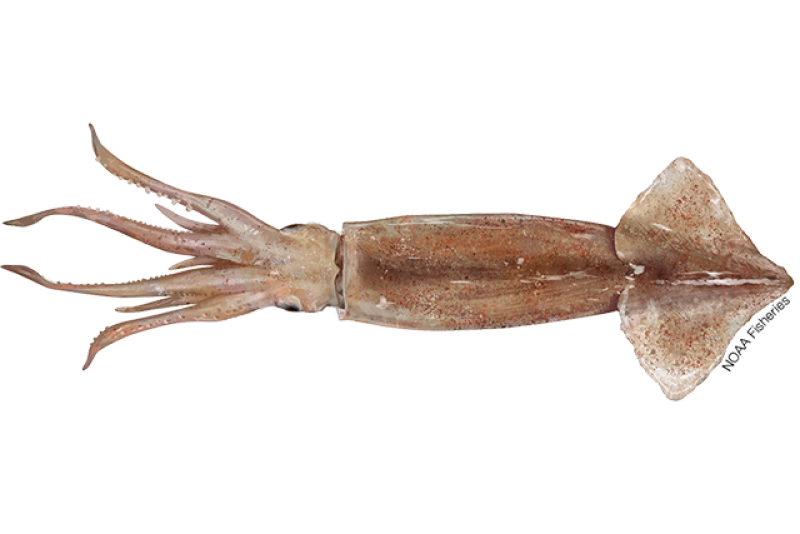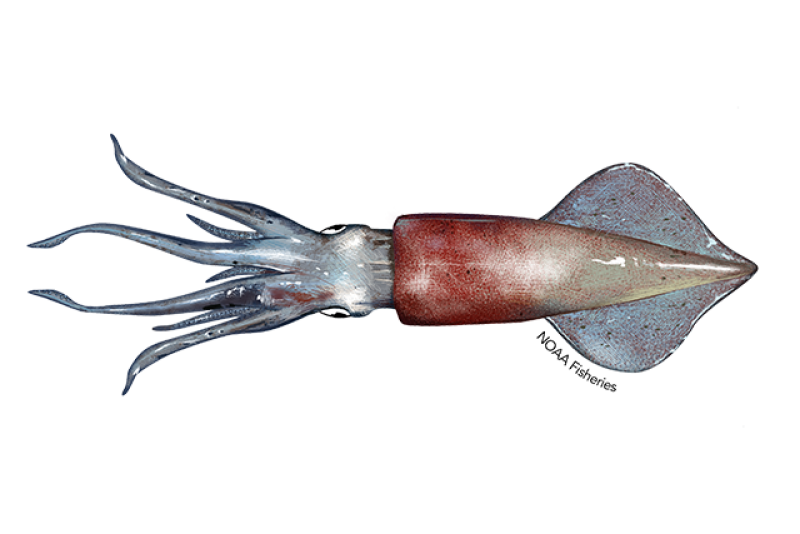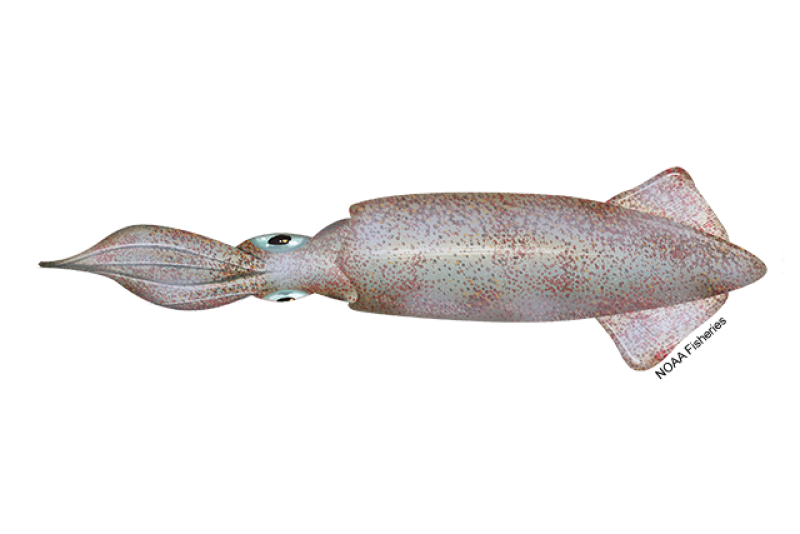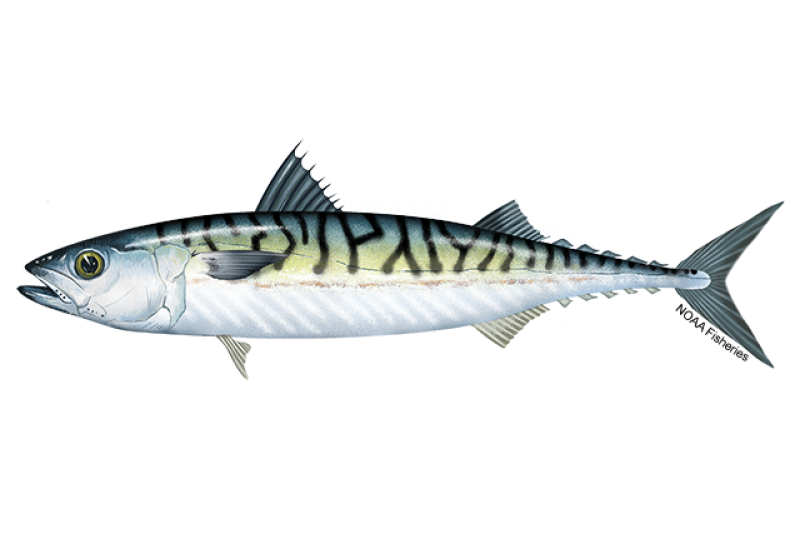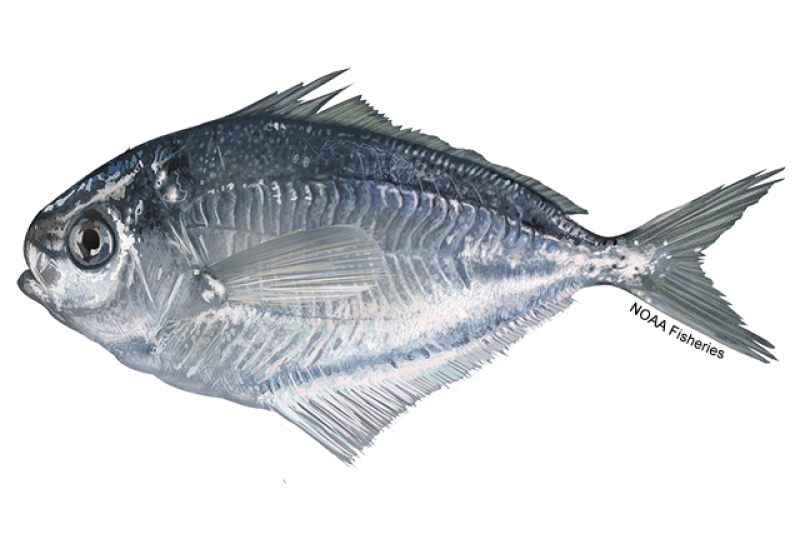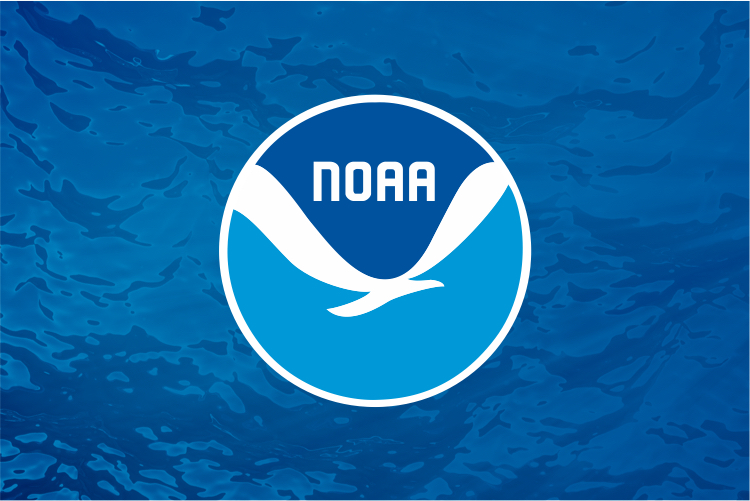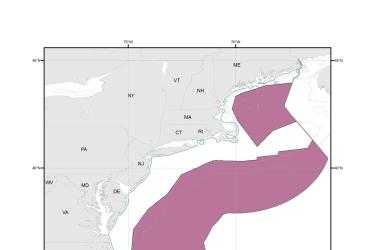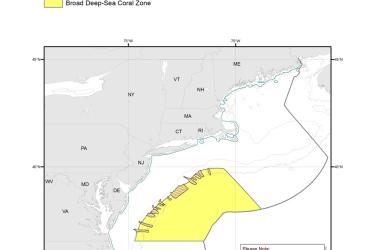Shortfin Squid
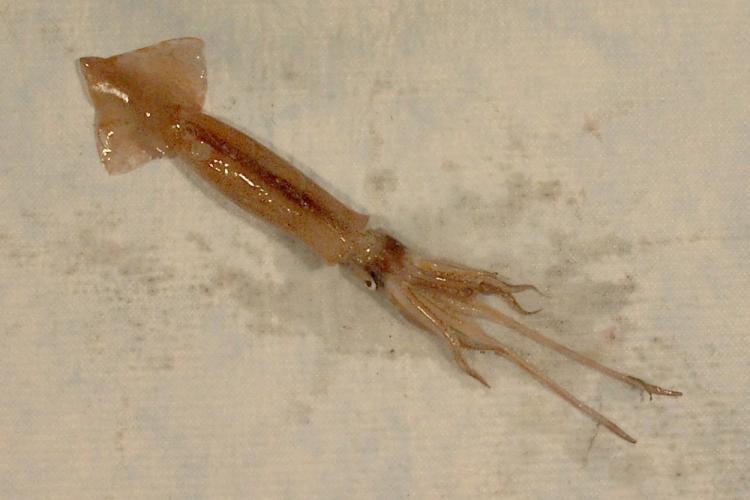 Shortfin squid. Credit: NOAA Fisheries
Shortfin squid. Credit: NOAA Fisheries
Shortfin squid. Credit: NOAA Fisheries
About the Species
 Shortfin squid. Credit: NOAA Fisheries
Shortfin squid. Credit: NOAA Fisheries
Shortfin squid. Credit: NOAA Fisheries
U.S. wild-caught shortfin squid is a smart seafood choice because it is sustainably managed and responsibly harvested under U.S. regulations.

Population
The population level is unknown, but management measures are in place.

Fishing Rate
Not subject to overfishing.

Habitat Impacts
Fishing gears used to harvest shortfin squid have minimal impacts on habitat.

Bycatch
Regulations are in place to minimize bycatch.
Population Status
- According to the latest assessment (2005 stock assessment), shortfin squid is not subject to overfishing. There is currently not enough information to determine the population size, so it is unknown. Summary stock assessment information can be found on Stock SMART.
Appearance
- Female shortfin squid range from 7 to 12 inches in mantle length, while males are 7 to 10.6 inches in mantle length.
- They can regulate their body color, but are primarily orange-colored with a brown stripe that extends along the top side of the mantle.
Biology
- Shortfin squid live for less than one year. They have a high natural mortality rate, and a long spawning season.
- Females can release multiple egg masses during a single spawning season, but die after they spawn. Spawning can occur year round with seasonal peaks from October to June.
- Shortfin squid have extremely variable birth, growth, and maturity rates. This makes them extremely sensitive to climate-driven changes.
- They grow about one millimeter a day.
- Shortfin squid are visual predators that eat crustaceans, fish, and other squid, including their own species.
- They are food for many fish, including bluefin tuna, silver hake, red hake, bluefish, goosefish, fourspot flounder, Atlantic cod, sea raven, spiny dogfish, and swordfish. Seabird predators include shearwaters, gannets, and fulmars.
- Shortfin squid undergo daily vertical migrations between cooler deep water and warmer surface water. They are nearest the seabed during the day, and higher in the water column during the night.
Where They Live
Range
- Shortfin squid inhabits the continental shelf and slope waters of the Northwest Atlantic Ocean, from Newfoundland to the central east coast of Florida.
- In the northwest Atlantic Ocean, shortfin squid are most often caught along the continental shelf break in depths between 150 to 275 meters.
Habitat
- Shortfin squid live in deep and shallow waters on the continental shelf, continental slope, and open ocean depending on the season.
- They are found in nearshore waters of the Gulf of Maine during summer and fall.
- During spring, shortfin squid migrate onto the continental shelf, and during late fall, they migrate off the continental shelf.
- Their egg masses float in mid-water.
- Spawning occurs in the waters off Rhode Island and New Jersey.
Fishery Management
- NOAA Fisheries and the Mid-Atlantic Fishery Management Council manage the shortfin squid fishery.
- Managed under the Atlantic Mackerel, Squid, and Butterfish Fishery Management Plan:
- Fishermen with a limited access permit can fish for unlimited amounts of shortfin squid while the fishery is open. All other fishermen must obtain an incidental catch permit, and have possession limits.
- An annual coastwide catch quota is set annually. Managers monitor annual quotas closely, as there can be large fluctuations in abundance from year to year.
Harvest
- Commercial fishery
- In 2022, commercial landings of shortfin squid totaled 12 million pounds, and were valued at $6.4 million according to the NOAA Fisheries commercial fishing landings database.
- Fisheries for shortfin squid reflect the species’ seasonal migrations.
- The majority of landings come from Rhode Island and New Jersey.
- Harvested for bait domestically, and exported for bait and food.
- Gear types, habitat impacts, and bycatch:
- The majority of shortfin squid is harvested June 1 through October 31 using small-mesh bottom trawls. The fishery is open year round, but the squid aren’t available in commercial quantities year round.
- Sandy or muddy habitat, where squid are fished, is less sensitive to the impacts of trawling.
- Small-mesh bottom trawls can incidentally catch marine mammals and large pelagic species, including pilot whales, common dolphin, swordfish, and a variety of sharks, ray, and tuna species. Finfish such as butterfish, hakes, longfin squid, summer flounder, herring, spiny dogfish, and Atlantic mackerel are also incidentally caught in this fishery.
- Measures to prevent or minimize bycatch include:
- Fishing must occur seaward of the 50-fathom depth line to reduce finfish and longfin inshore squid bycatch.
- Outreach to fishermen to educate them on actions to take in the event of a marine mammal interaction.
- Real-time communication to vessels regarding hotspots of marine mammal interactions.
Scientific Classification
- Shortfin squid inhabits the continental shelf and slope waters of the Northwest Atlantic Ocean, from Newfoundland to the central east coast of Florida.
- In the northwest Atlantic Ocean, shortfin squid are most often caught along the continental shelf break in depths between 150 to 275 meters.
- Shortfin squid live in deep and shallow waters on the continental shelf, continental slope, and open ocean depending on the season.
- They are found in nearshore waters of the Gulf of Maine during summer and fall.
- During spring, shortfin squid migrate onto the continental shelf, and during late fall, they migrate off the continental shelf.
- Their egg masses float in mid-water.
- Spawning occurs in the waters off Rhode Island and New Jersey.
Fishery Management
- NOAA Fisheries and the Mid-Atlantic Fishery Management Council manage the shortfin squid fishery.
- Managed under the Atlantic Mackerel, Squid, and Butterfish Fishery Management Plan:
- Fishermen with a limited access permit can fish for unlimited amounts of shortfin squid while the fishery is open. All other fishermen must obtain an incidental catch permit, and have possession limits.
- An annual coastwide catch quota is set annually. Managers monitor annual quotas closely, as there can be large fluctuations in abundance from year to year.
Harvest
- Commercial fishery
- In 2022, commercial landings of shortfin squid totaled 12 million pounds, and were valued at $6.4 million according to the NOAA Fisheries commercial fishing landings database.
- Fisheries for shortfin squid reflect the species’ seasonal migrations.
- The majority of landings come from Rhode Island and New Jersey.
- Harvested for bait domestically, and exported for bait and food.
- Gear types, habitat impacts, and bycatch:
- The majority of shortfin squid is harvested June 1 through October 31 using small-mesh bottom trawls. The fishery is open year round, but the squid aren’t available in commercial quantities year round.
- Sandy or muddy habitat, where squid are fished, is less sensitive to the impacts of trawling.
- Small-mesh bottom trawls can incidentally catch marine mammals and large pelagic species, including pilot whales, common dolphin, swordfish, and a variety of sharks, ray, and tuna species. Finfish such as butterfish, hakes, longfin squid, summer flounder, herring, spiny dogfish, and Atlantic mackerel are also incidentally caught in this fishery.
- Measures to prevent or minimize bycatch include:
- Fishing must occur seaward of the 50-fathom depth line to reduce finfish and longfin inshore squid bycatch.
- Outreach to fishermen to educate them on actions to take in the event of a marine mammal interaction.
- Real-time communication to vessels regarding hotspots of marine mammal interactions.
Scientific Classification
| Kingdom | Animalia | Phylum | Mollusca | Class | Cephalopoda | Order | Oegopsida | Family | Ommastrephidae | Genus | Illex | Species | illecebrosus |
|---|
Last updated by NOAA Fisheries on 03/27/2024
Recreational Fishing Regulations
Possession Limits:
There is no recreational possession limit for shortfin (Illex) squid. If you are on a trip carrying paying customers and you possess Illex squid in federal waters, you must hold a Category 2 Squid/Mackerel/Butterfish Charter Party permit.
Fish Size Limits:
Minimum Fish Size: None
Maximum Fish Size: None
Reporting A Recreational Catch
Charter/Party and Recreational Reporting
Catch Reporting and Vessel Trip Reports
If the owner of a party or charter boat is issued only a charter/party permit, and is carrying passengers for hire, then they must complete a VTR for each trip on which they land any fish.
Interactive Voice Response System Requirements
The mackerel, squid, and butterfish fisheries do not have any IVR requirements. However, if you are participating in a research program such as research set-aside (RSA) or fishing with an exempted fishing permit (EFP), there are IVR requirements. Please refer to your RSA or EFP paperwork for instruction on using IVR.
Marine Recreational Information Program
The Marine Recreational Information Program (MRIP) is a system of coordinated voluntary data collection programs designed to estimate recreational catch and effort
Last updated by NOAA Fisheries on 03/27/2024
Commercial Fishing Regulations
Current Specifications
Specifications are reviewed annually and are adjusted as new information becomes available.
2023 Shortfin (Illex) Squid Specifications in Metric Tons (mt)
| Specification | 2023 |
| Overfishing Limit (OFL) | Unknown |
| Acceptable Biological Catch (ABC) | 40,000 |
| Initial Optimum Yield (IOY) | 38,631 |
| Domestic Annual Harvest (DAH)/Domestic Annual Processing (DAP) | 38,631 |
Trip Limits
| Permit Category | Illex Squid | Longfin Squid | Butterfish |
| SMB 3 Squid/Butterfish Incidental | 10,000 lb | 250 lb | 600 lb |
| SMB 6 Illex Squid Moratorium Permit | Unlimited | - | - |
Fish Size Limits
Minimum fish size: Not applicable
Maximum fish size: Not applicable
Accountability Measures
When 94 percent of the Illex squid DAH is projected to be harvested, the directed fishery will be limited to a 10,000-pound possession limit for the remainder of the calendar year.
Reporting A Commercial Catch
Catch Reporting and Vessel Trip Reports (VTR): Owner/operators participating in the Illex squid fishery must submit trip reports weekly. Reports must be postmarked or received by midnight of the Tuesday following the reporting week (Sunday through Saturday). If a trip starts in one week, and offloads in the next, it should be reported in the week the catch was offloaded.
Dealer Reporting
48-hour Illex reporting required after July 15 for commercial dealers for the remainder of the fishing year.
VMS Requirements: The owner or operator of a vessel issued an Illex squid moratorium permit must report catch (retained and discarded) of longfin squid daily via VMS. Reports are required even if Illex squid caught that day have not yet been landed
Last updated by NOAA Fisheries on 03/27/2024
Seafood Facts

Is Shortfin Squid Sustainable?
U.S. wild-caught shortfin squid is a smart seafood choice because it is sustainably managed and responsibly harvested under U.S. regulations.
Availability
Summer and fall.
Source
U.S. wild-caught from Maine to North Carolina.
Taste
Mild, and subtly sweet.
Texture
Firm and meaty.
Color
Raw squid is ivory colored with orange speckling and a brown stripe that runs down the mantle. Cooked squid is opaque white.
Health Benefits
Squid are an excellent source of selenium, riboflavin, and vitamin B12.
Nutrition Facts
Servings: 1; Serving Weight: 100 g; Calories: 92; Protein: 15.58 g; Total Fat: 1.38 g; Total Saturated Fatty Acids: 0.358 g; Carbohydrate: 3.08 g; Total Sugars: 0 g; Total Dietary Fiber: 0 g; Cholesterol: 233 mg; Selenium: 44.8 mcg; Sodium: 44 mgMore Information
Last updated by NOAA Fisheries on 03/27/2024
Seafood News
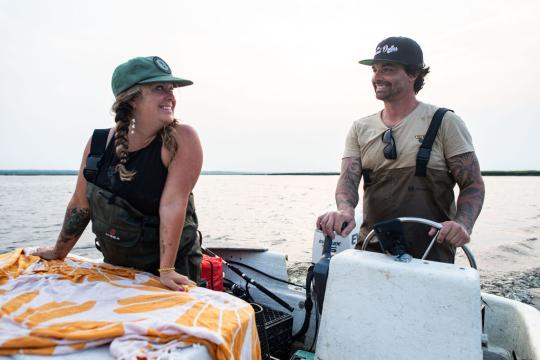 Photo credit: Christine Hochkeppel, christinehochkeppel.com
Photo credit: Christine Hochkeppel, christinehochkeppel.com
 Port of Dutch Harbor and the village of Unalaska in the Aleutian Chain on the edge of the southeastern Bering Sea. Dutch Harbor the largest fishing port by volume in the U.S. Credit: NOAA Fisheries/Paul Hillman.
Port of Dutch Harbor and the village of Unalaska in the Aleutian Chain on the edge of the southeastern Bering Sea. Dutch Harbor the largest fishing port by volume in the U.S. Credit: NOAA Fisheries/Paul Hillman.
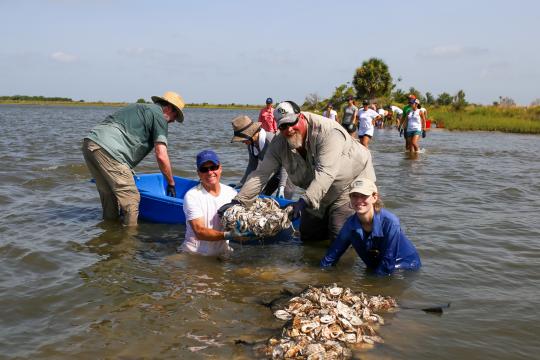 Volunteers build an oyster reef from recycled oyster shells (Photo: Galveston Bay Foundation)
Volunteers build an oyster reef from recycled oyster shells (Photo: Galveston Bay Foundation)
Regulated, Closed, and Access Areas
Atlantic Mackerel, Squid, and Butterfish Fishery Restricted Areas
| Oceanographer Canyon | Lydonia Canyon | Northern Scup Gear Restricted Area (GRA) | Southern Scup GRA |
| January 1–December 31 | January 1–December 31 | November 1–December 31 | January 1–March 15 |
| Bottom trawl gear prohibited | Bottom trawl gear prohibited | Minimum mesh size of 5.0 inch diamond mesh | Minimum mesh size of 5.0 inch diamond mesh |
| Transit allowed if bottom trawl gear is stowed and not available for immediate use. | Transit allowed if bottom trawl gear is stowed and not available for immediate use. | Transit allowed if codends less than 5.0 inches are stowed and not available for immediate use. | Transit allowed if codends less than 5.0 inches are stowed and not available for immediate use. |
| Applies to all permitted mackerel, squid, or butterfish vessels | Applies to all permitted mackerel, squid, or butterfish vessels | Applies to all trawl vessels fishing for longfin squid, black sea bass, or silver hake (whiting) | Applies to all trawl vessels fishing for longfin squid, black sea bass, or silver hake (whiting) |
*Coordinates for each area are listed below.
Oceanographer and Lydonia Canyons
| Oceanographer Canyon Coordinates | Lydonia Canyon Coordinates | |||
N. Lat. | W. Long. | N. Lat. | W. Long. | |
| 40°10.0' | 68°12.0' | 40°16.0' | 67°34.0' | |
| 40°24.0' | 68°09.0' | 40°16.0' | 67°42.0' | |
| 40°24.0' | 68°08.0' | 40°20.0' | 67°43.0' | |
| 40°10.0' | 67°59.0' | 40°27.0' | 67°40.0' | |
| 40°10.0' | 68°12.0' | 40°27.0' | 67°38.0' | |
| 40°16.0' | 67°34.0' | |||
Scup GRAs
| Southern GRA Coordinates | Northern GRA Coordinates | |||
N. Lat. | W. Long. | N. Lat. | W. Long. | |
| 39°20' | 72°53' | 41°00' | 71°00' | |
| 39°20' | 72°28' | 41°00' | 71°30' | |
| 38°00' | 73°58' | 40°00' | 72°40' | |
| 37°00' | 74°43' | 40°00' | 72°05' | |
| 36°30' | 74°43' | 41°00' | 71°00' | |
| 36°30' | 75°03' | |||
| 37°00' | 75°03' | |||
| 38°00' | 74°23' | |||
| 39°20' | 72°53' | |||
Illex Squid Exemption Area
Otter trawl vessels possessing longfin squid harvested in or from federal waters and fishing for shortfin (Illex) squid during the months of June, July, August in Trimester II, and September in Trimester III, are exempt from the longfin squid gear requirements specified in 50 CFR 648.23(a)(2), as long as:
- Any net, or any piece of net, with a mesh size less than 17⁄8 inches diamond mesh in Trimester II, and 21⁄8 inches diamond mesh in Trimester III, is stowed and not available for immediate use when the vessel is landward of the Illex Squid Exemption Area (coordinates below).
- Any net, or any piece of net, equipped with a net strengthener with a mesh opening smaller than 5 inches (diamond or square mesh) is stowed and not available for immediate use when the vessel is landward of the Illex Squid Exemption Area.
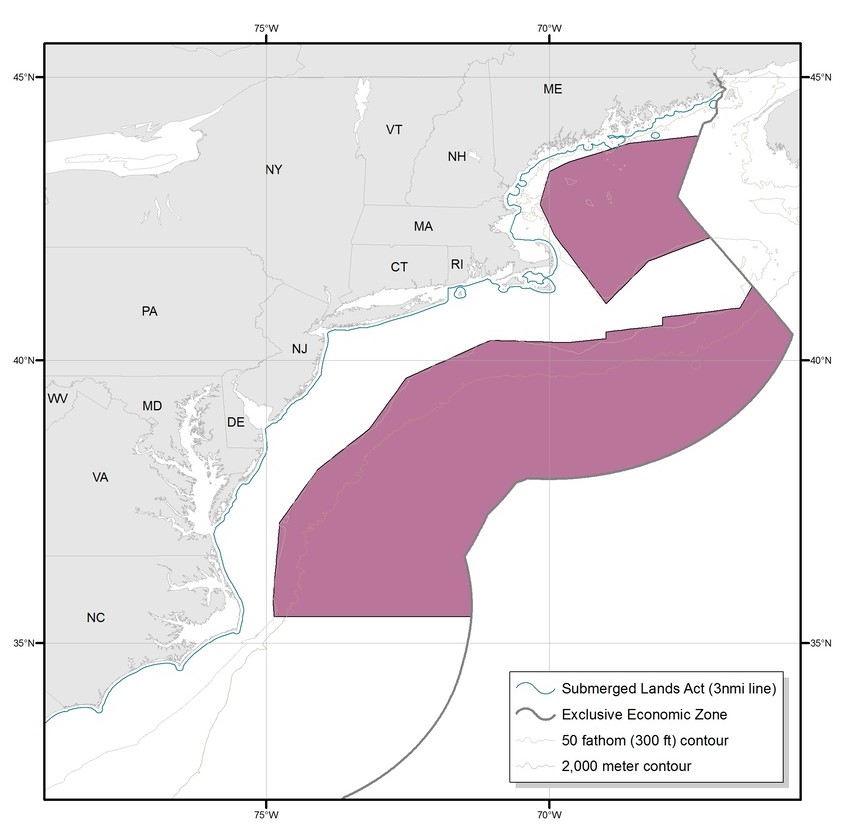
| N. Lat. | W. Long. |
| 43°58.0′ | [1] |
| 43°58.0′ | 67°22.0′ |
| 43°50.0′ | 68°35.0′ |
| 43°30.0′ | 69°40.0′ |
| 43°20.0′ | 70°00.0′ |
| 42°45.0′ | 70°10.0′ |
| 42°13.0′ | 69°55.0′ |
| 41°00.0′ | 69°00.0′ |
| 41°45.0′ | 68°15.0′ |
| 42°10.0′ | [2] 67°10.0′ |
| 41°18.6′ | [2] 66°24.8′ |
| 40°55.5′ | 66°38.0′ |
| 40°45.5′ | 68°00.0′ |
| 40°37.0′ | 68°00.0′ |
| 40°30.0′ | 69°00.0′ |
| 40°22.7′ | 69°00.0′ |
| 40°18.7′ | 69°40.0′ |
| 40°21.0′ | 71°03.0′ |
| 39°41.0′ | 72°32.0′ |
| 38°47.0′ | 73°11.0′ |
| 38°04.0′ | 74°06.0′ |
| 37°08.0′ | 74°46.0′ |
| 36°00.0′ | 74°52.0′ |
| 35°45.0′ | 74°53.0′ |
| 35°28.0′ | 74°52.0′ |
| 35°28.0′ | [3] |
[1] The intersection of 43°58.0′ N. latitude and the US-Canada Maritime Boundary.
[2] Points M9 and M10 are intended to fall along and are connected by the US-Canada Maritime Boundary.
[3] The intersection of 35°28.0′ N. latitude and the outward limit of the U.S. EEZ.
More Information
Last updated by NOAA Fisheries on 03/27/2024
Management Overview
How is the fishery managed?
The mackerel, squid, and butterfish fisheries are each managed by annual quotas, accountability measures, and possession limits by permits.
What is the fishing year for this fishery?
January 1–December 31
What are the different management areas for the mackerel, squid, and butterfish fisheries?
The management unit for these species is the Atlantic Coast, but these species are predominately prosecuted from Maine to North Carolina.
Management Plans
Mackerel, squid, and butterfish are managed in federal waters under the Atlantic Mackerel, Squid and Butterfish Management Plan (FMP) by the Mid-Atlantic Fishery Management Council and NOAA Fisheries.
Regulatory History
1978: Atlantic Mackerel FMP established management of Atlantic mackerel fishery
1978: Atlantic Butterfish FMP established management of Atlantic butterfish fishery
1978: Squid FMP established management of squid fisheries
1979: Atlantic Mackerel Amendment 1 continued management of the Atlantic mackerel fishery
1979: Squid Amendment 1 continued management of the squid fishery
1980: Atlantic Butterfish Amendment 1 continued management of the Atlantic butterfish fishery
1980: Atlantic Mackerel Amendment 2 continued management of the Atlantic mackerel fishery.
1980: Atlantic Butterfish Amendment 2 continued management of the Atlantic butterfish fishery.
1983: Merged FMP consolidated management of Atlantic mackerel, squid, and butterfish fisheries under a single FMP.
1984: Amendment 1 implemented squid OY adjustment mechanism and revised the Atlantic mackerel mortality rate.
1986: Amendment 2 revised squid bycatch TALFF allowances, implemented framework adjustment process, converted expiration of fishing permits from indefinite to annual, and equated fishing year with calendar year.
1991: Amendment 3 established overfishing definitions for all four species.
1991: Amendment 4 limited the activity of directed foreign fishing and joint venture transfers to foreign vessels and allowed for specification of OY for Atlantic mackerel for up to three years.
1996: Amendment 5 adjusted Loligo MSY; eliminated directed foreign fisheries for Loligo, Illex, and butterfish; instituted a dealer and vessel reporting system; instituted an operator permitting system; implemented a limited access system for Loligo, Illex and butterfish; and expanded the management unit to include all Atlantic mackerel, Loligo, Illex, and butterfish under U.S. jurisdiction.
1997: Amendment 6 revised the overfishing definitions for Loligo, Illex, and butterfish; established directed fishery closure at 95 percent of DAH for Loligo, Illex and butterfish with post-closure trip limits for each species; and established a mechanism for seasonal management of the Illex fishery to improve the yield-per recruit.
1997: Amendment 7 established consistency among FMPs in the NE region of the U.S. relative to vessel permitting, replacement and upgrade criteria.
1998: Amendment 8 brought the FMP into compliance with new and revised National Standards and other required provisions of the Sustainable Fisheries Act. This action also added a framework adjustment procedure.
2001: Framework 1 (PDF, 80 pages) created a quota set-aside for the purpose of conducting scientific research
2002: Framework 2 (PDF, 4 pages) extended the moratorium on entry to the Illex fishery for an additional year; established that previous year specifications apply when specifications for the management unit are not published prior to the start of the fishing year (excluding TALFF specifications); and allowed for the specification of management measures for Loligo for a period of up to three years.
2003: Framework 3 (PDF, 3 pages) extended the moratorium on entry to the Illex fishery for an additional year.
2004: Framework 4 extended the moratorium on entry to the Illex fishery for an additional five years
2007: Amendment 12 implemented standardized bycatch reporting methodology.
2008: Amendment 9 allowed for multi-year specifications for all four managed species (mackerel, butterfish, Illex, and Loligo) for up to 3 years; extended the moratorium on entry into the Illex fishery, without a sunset provision; adopted biological reference points for Loligo recommended by the stock assessment review committee (SARC); designated EFH for Loligo eggs based on available information; and prohibited bottom trawling by MSB-permitted vessels in Lydonia and Oceanographer Canyons.
2010: Amendment 10 implemented a butterfish rebuilding program, increased the Loligo minimum mesh in Trimesters 1 and 3, and implemented a 72-hour trip notification requirement for the Loligo fishery.
2010: Amendment 13 implemented Annual Catch Limits (ACLs), Annual Catch Targets (ACTs), and Accountability Measures (AMs).
2011: Amendment 11 implemented Limited Access in the Atl. mackerel fishery, updated EFH for all MSB species, and established a recreational-commercial allocation.
2012: Framework 5 broadened the scope of individuals who can perform hold measurements for limited access mackerel vessels
2012: Framework 6 clarified the Council's risk policy and describes the limited circumstances under which acceptable biological catch (ABC) can be increased for stocks without status determination criteria on overfishing.
2013: Framework 7 converted the butterfish mortality cap from a catch cap to a discard cap
2014: Amendment 14 implemented a variety of reporting and monitoring requirements for Atlantic mackerel and longfin squid fisheries, and implemented a river herring and shad catch cap for the Atlantic mackerel fishery (Appendices). Final Rule.
2013: Amendment 17 modified accountability measures for the Council's recreational fisheries, including Atlantic mackerel. Final Rule.
2014: Framework 8 implemented changes to improve operation of the butterfish discard cap in the longfin squid fishery and the directed butterfish fishery. Final Rule.
2015: Amendment 15 implemented Standardized Bycatch Reporting Methodology. Final Rule.
2015: Amendment 19 eliminated the requirement for vessel owners to submit "did not fish" reports for the months or weeks when their vessel was not fishing. This action also removed some of the restrictions for upgrading vessels listed on Federal fishing permits. Final Rule.
2015: Framework 9 established measures to enhance catch monitoring and address slippage (catch that is discarded before it has been sampled by observers) in the Atlantic mackerel fishery.
2016: Amendment 16 - Deep Sea Corals Amendment established management measures to protect deep sea corals from the impacts of commercial fishing gear in the Mid-Atlantic region. Final Rule.
2017: Amendment 18 - Unmanaged Forage Omnibus Amendment implemented management measures to prevent the development of new, and the expansion of existing, commercial fisheries on certain forage species in the Mid-Atlantic. Final Rule.
2017: Framework 10 - Omnibus For-Hire Electronic Trip Reporting Framework implemented a requirement for vessels that hold party/charter permits for Council-managed species to submit vessel trip reports electronically (eVTRs) while on a trip carrying passengers for hire.
2018: Framework 11 - Omnibus Acceptable Biological Catch Framework established a process for setting constant multi-year Acceptable Biological Catch (ABCs) limits for Council-managed fisheries; clarified that the Atlantic Bluefish, Tilefish, and Atlantic Mackerel, Squid, and Butterfish FMPs will now automatically incorporate the best available scientific information in calculating ABCs (as all other Mid-Atlantic management plans do) rather than requiring a separate management action to adopt them; clarified the process for setting ABCs for each of the four types of ABC control rules. Final Rule.
2018: Amendment 20 - Squid Amendment reduced latent directed permits, created limited access incidental permits, and lowered Trimester 2 post-closure trip limit to 250 pounds to discourage directed fishing after closures. Final Rule.
2018: Framework 12 - Atlantic Mackerel Closure Provisions Framework allowed the possession of 5,000 lb of Atlantic mackerel after 100 percent of the domestic annual harvest is caught instead of prohibiting the possession of Atlantic mackerel for the rest of the year. Final Rule.
2019: Framework 13 - Established a 5-year rebuilding plan for Atlantic mackerel, set 2019-2021 mackerel specifications, modified the Mid-Atlantic Council’s risk policy, and modified in-season closure measures for mackerel. Final Rule.
2020: Amendment 21 - Chub Mackerel Amendment established management of Atlantic chub mackerel through the Mackerel, Squid, and Butterfish FMP. Final Rule.
2020: Framework 14 - Omnibus Commercial Electronic Reporting Framework established a requirement for commercial vessels with federal permits for Mid-Atlantic and New England Council-managed species to submit eVTRs within 48 hrs after the conclusion of a trip. Final Rule.
2020: Framework 15 - Omnibus ABC and Risk Policy Framework modified the Mid-Atlantic Council’s ABC control rule and risk policy. Final Rule.
2023: Amendment 23 - Atlantic Mackerel Rebuilding 2.0 Amendment revised the rebuilding plan for mackerel, set 2023 mackerel fishery specifications, established a recreational possession limit for mackerel, and modified in-season closure measures for mackerel to include an initial closure with different thresholds based on time of year (before vs. on/after May 1) and a final closure when the fishery is close to harvesting the full commercial quota. Final Rule.
Under Development
2023: Illex Vessel Hold Capacity Framework was initiated to develop measures that would constrain future increases in capacity in the Illex squid fishery. Specifically, the Council is considering implementing a volumetric vessel hold baseline requirement and upgrade restriction for all Illex limited access permits.
More Information
Last updated by NOAA Fisheries on 03/27/2024
Science Overview
NOAA Fisheries conducts various research activities on the biology, behavior, and population health of shortfin (Illex) squid. The results of this research are used to inform management decisions for this species.
For detailed information about stock status, management, assessments, and resource trends, you can search for Illex squid, and any other species of interest, using NOAA’s StockSMART web tool.
Stock Assessment Review Index
Fishery Stock Assessments in New England and the Mid-Atlantic provides general information about stock assessments, and the Stock Assessment Review Index contains copies of completed assessment documents.
More Information
Last updated by NOAA Fisheries on 03/27/2024
Research
2019 Northeast Trawl Advisory Panel Wingspread Research
Consistently fishing a trawl survey net is essential to creating a consistent data time series.
New England/Mid- Atlantic Fishery Management Plans
We manage 14 fisheries in our region, six with the New England Council, five with the Mid-Atlantic Council, and two jointly.
Letters of Authorization Programs in the Greater Atlantic Region
This summary of the regulations and requirements for each Letter of Authorization (LOA) program under the respective Fishery Management Plans is subject to change.
Quota Monitoring in the Greater Atlantic Region
Provided on a weekly basis, catch and landings reports are used to evaluate and support our fishery management programs.
Last updated by NOAA Fisheries on 03/27/2024
